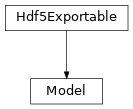Model
full name: tenpy.models.model.Model
parent module:
tenpy.models.modeltype: class
Inheritance Diagram

Methods
|
|
Shallow copy of self. |
|
|
Repeat the unit cell for infinite MPS boundary conditions; in place. |
Returns the expected saving factor for RAM based on charge conservation. |
|
|
Return a (shallow) copy with extracted segment of MPS. |
|
Load instance from a HDF5 file. |
Get list of model-dependent extra default measurements. |
|
|
Modify self in place to group sites. |
|
Export self into a HDF5 file. |
|
Reconstruct Hamiltonian for time-dependent models, potentially (!) in-place. |
Class Attributes and Properties
class attribute. |
|
Reproducible numpy pseudo random number generator. |
- class tenpy.models.model.Model(lattice)[source]
Bases:
Hdf5ExportableBase class for all models.
The common base to all models is the underlying Hilbert space and geometry, specified by a
Lattice.- Parameters:
lattice (
Lattice) – The lattice defining the geometry and the local Hilbert space(s).
- lat
The lattice defining the geometry and the local Hilbert space(s).
- Type:
Lattice
- logger = <Logger tenpy.models.model.Model (WARNING)>
class attribute.
- Type:
- Type:
An instance of a logger; see Logging and terminal output. NB
- property rng
Reproducible numpy pseudo random number generator.
If you want to add randomness/disorder to your model, it is recommended use this random number generator for reproducibility of the model:
self.rng.random(size=[3, 5])
Especially for models with time-dependence, you can/will otherwise end up generating a new disordered at each time-step!
Options
- random_seed :: None | int
Defaults to 123456789. Seed for numpy pseudo random number generator which can be used as e.g.
self.rng.random(...).
- save_hdf5(hdf5_saver, h5gr, subpath)[source]
Export self into a HDF5 file.
Same as
save_hdf5(), but handlerng.
- classmethod from_hdf5(hdf5_loader, h5gr, subpath)[source]
Load instance from a HDF5 file.
Same as
from_hdf5(), but handlerng.
- extract_segment(first=0, last=None, enlarge=None)[source]
Return a (shallow) copy with extracted segment of MPS.
- Parameters:
first (int) – See
extract_segment().last (int) – See
extract_segment().enlarge (int) – See
extract_segment().
- Returns:
cp – A shallow copy of self with MPO and lattice extracted for the segment.
- Return type:
- enlarge_mps_unit_cell(factor=2)[source]
Repeat the unit cell for infinite MPS boundary conditions; in place.
This has to be done after finishing initialization and can not be reverted.
- Parameters:
factor (int) – The new number of sites in the MPS unit cell will be increased from N_sites to
factor*N_sites_per_ring. Since MPS unit cells are repeated in the x-direction in our convention, the lattice shape goes from(Lx, Ly, ..., Lu)to(Lx*factor, Ly, ..., Lu).
- group_sites(n=2, grouped_sites=None)[source]
Modify self in place to group sites.
Group each n sites together using the
GroupedSite. This might allow to do TEBD with a Trotter decomposition, or help the convergence of DMRG (in case of too long range interactions).This has to be done after finishing initialization and can not be reverted.
- Parameters:
n (int) – Number of sites to be grouped together.
grouped_sites (None | list of
GroupedSite) – The sites grouped together.
- Returns:
grouped_sites – The sites grouped together.
- Return type:
list of
GroupedSite
- get_extra_default_measurements()[source]
Get list of model-dependent extra default measurements.
Extra measurements for a
Simulation, which depend on the model itself - subclasses should override this method). E.g., aMPOModelshould measure the energy w.r.t. the MPO (Seem_energy_MPO()). However, aNearestNeighborModelshould use the functionm_bond_energies(). The extra measurements are added to the default measurements in_connect_measurements().- Returns:
m_extra_default_list
- Return type:
- update_time_parameter(new_time)[source]
Reconstruct Hamiltonian for time-dependent models, potentially (!) in-place.
For
TimeDependentHAlgorithm, we assume that the model reads out the parameterself.options['time'], and reinitialize/update the model calling this method.- Parameters:
new_time (float) – Time at which the (time-dependent) Hamiltonian should be constructed.
- Returns:
updated_model – Model of the same class as self with Hamiltonian at time new_time. Note that it can just be a reference to self if modified in place, or an entirely new constructed model.
- Return type:
model
- estimate_RAM_saving_factor()[source]
Returns the expected saving factor for RAM based on charge conservation.
- Returns:
factor – saving factor, due to conservation
- Return type:
Options
- mem_saving_factor :: None | float
Quantizes the RAM saving, due to conservation laws, to be used by
estimate_simulation_RAM(). By default it is 1/mod, or 1/4 in case of mod=1. However, for some classes this factor might be overwritten, if a better approximation is known. In the best case, the user can adjust this model parameter to enhance the estimate.